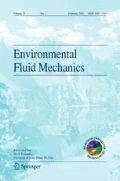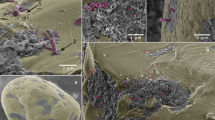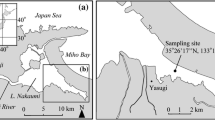Abstract
A mechanistic model of sedimentary oxygen demand (SOD) for hyporheic flow is presented. The permeable sediment bed, e.g. sand or fine gravel, is considered with hydraulic conductivity in the range \(0.1 < K < 20\) cm/s. Hyporheic pore water flow is induced by pressure fluctuations at the sediment/water interface due to near-bed turbulent coherent motions. A 2-D advection–diffusion equation is linked to the pore water flow model to simulate the effect of advection–dispersion driven by interstitial flow on oxygen transfer through the permeable sediment. Microbial oxygen uptake in the sediment is expressed as a function of the microbial growth rate, and is related to the sediment properties, i.e. the grain diameter \((d_{s})\) and porosity \((\phi )\). The model describes the significance of sediment particle size to oxygen transfer through the sediment and microbial oxygen uptake: With increasing grain diameter \((d_{s})\), the hydraulic conductivity \((K)\) increases so does the oxygen transfer rate, while particle surface area per volume (the available surface area for colonization by biofilms) decreases reducing the microbial oxygen uptake rate. Simulation results show that SOD increases as the hydraulic conductivity \((K)\) increases before a threshold has been reached. After that, SOD diminishes with the increment of the hydraulic conductivity \((K)\).







Similar content being viewed by others
Abbreviations
- \(A\) :
-
Total surface area of particles in the unit volume of sediment \((\text{ cm}^{2})\)
- \(C\) :
-
Dissolved oxygen concentration \((\text{ mg}/\text{ l})\)
- \(C_{\infty }\) :
-
Dissolved oxygen concentration in the bulk water \((\text{ mg}/\text{ l})\)
- \(D_{e}\) :
-
Effective diffusion coefficient for dissolved oxygen in sediment pore system \((\text{ cm}^{2}/\text{ s})\)
- \(D_{m}\) :
-
Molecular diffusion coefficient for dissolved oxygen in water \((\text{ cm}^{2}/\text{ s})\)
- \(D_{xx},D_{xy},D_{yx},D_{yy}\) :
-
The components of the two-dimensional dispersion coefficient tensor \((\text{ cm}^{2}/\text{ s})\)
- \(d_{s}\) :
-
Sediment grain diameter (cm)
- \(g\) :
-
Gravitational acceleration \((=9.8\,\text{ m}/\text{ s}^{2})\)
- \(h\) :
-
Sediment layer thickness (cm)
- \(i(=\sqrt{-1})\) :
-
Imaginary unit
- \(K\) :
-
Darcy hydraulic conductivity (cm/s)
- \(k_{d}\) :
-
First-order decay coefficient \((\text{ d}^{-1})\)
- \(Ko_{2}\) :
-
Half saturation constant for dissolved oxygen \((\text{ mg}/\text{ l})\)
- \(N\) :
-
Number of particles in the unit volume of sediment
- SOD :
-
Sedimentary oxygen demand \((\text{ gm}^{-2}/\text{ d})\)
- \(U_{*}\) :
-
Bed shear velocity \((\text{ cm}/\text{ s})\)
- \(u\) :
-
Seepage velocity component in stream-wise direction \((\text{ cm}/\text{ s})\)
- \(v\) :
-
Seepage velocity component in vertical direction \((\text{ cm}/\text{ s})\)
- \(\left| V \right|=\sqrt{u^{2}+v^{2}}\) :
-
Magnitude of the seepage velocity
- \(V_{s}\) :
-
Total volume of particles in the unit volume of sediment \((\text{ cm}^{3})\)
- \(X\) :
-
Biomass concentration of the aerobic heterotrophs \((\text{ mg}/\text{ l})\)
- \(X_{max}\) :
-
Maximum possible biomass concentration \((\text{ mg}/\text{ l})\)
- \(x\) :
-
Longitudinal coordinate (cm)
- \(y\) :
-
Vertical coordinate (cm)
- \(Y_{c}\) :
-
Effective yield for the microbial utilization of DO \((\text{ mgXmgDO}^{-1})\)
- \(\alpha \) :
-
Possible biomass concentration per unit area of particles \((\text{ mg}/\text{ cm}^{2})\)
- \(\alpha _{L}\) :
-
Longitudinal dispersivity (cm)
- \(\alpha _{T}\) :
-
Transverse dispersivity (cm)
- \(\Delta t\) :
-
Time step
- \(\upmu \) :
-
Maximum oxidation rate \((\text{ mgl}^{-1}\text{ d}^{-1})\)
- \(\rho \) :
-
Fluid (water) density \((\text{ g}/\text{ cm}^{3})\)
- \(\tau \) :
-
Bed shear stress \((\text{ N}/\text{ cm}^{2})\)
- \(\upvarphi \) :
-
Sediment porosity and
- \(\chi \) :
-
Wave number \((\text{ cm}^{-1})\)
References
Bear J (1972) Dynamics of fluids in porous media. American Elsevier, New York
Benekos DI (2005) On the determination of transverse dispersivity: experiments and simulations in a helixand cochlea. Ph.D. Dissertation, Stanford University, p 122
Cardenas MB, Wilson JL, Zlotnik VA (2004) Impact of heterogeneity, bedforms and stream curvature on sub-channel hyporheic exchange. Water Resour Res 40, W08307. doi:10.1029/2004WR003008
Cardenas MB, Wilson JL (2006) The influence of ambient groundwater discharge on exchange zones induced by current-bedform interactions. J Hydrol 331:103–109
Cardenas MB, Wilson JL (2007) Hydrodynamics of coupled flow above and below a sediment-water interface with triangular bedforms. Adv Water Resour 30:301–313
Ditoro DM, Paquin PR, Subburamu KL, Gruber DA (1990) Sediment oxygen demand model: methane and ammonia oxidation. J Environ Eng, ASCE 116(5):945–986
Elliott AH, Brooks NH (1997) Transfer of non-sorbing solutes to a streambed with bed forms: Theory. Water Resour Res 33(1):123–136
Hargrave BT (1972) Aerobic decomposition of sediment and detritus as a function of particle surface area and organic content. Limnol Oceanogr 17:583–596
Higashino M, Gantzer CJ, Stefan HG (2004) Unsteady Diffusional Mass Transfer at the Sediment/Water Interface: Theory and Significance for SOD Measurements. Water Res 38:1–12
Higashino M, Stefan HG (2005) Oxygen Demand by a Sediment Bed of Finite Length. J Environ Eng, ASCE 131(3):350–358
Higashino M, O’Connor BL, Hondzo M, Stefan HG (2008) Oxygen transfer from flowing water to microbes in an organic sediment bed. Hydrobiologia 614:219–231
Higashino M, Clark JJ, Stefan HG (2009) Porewater flow due to near-bed turbulence and associate solute transfer in a stream or lake sediment bed. Water Resour Res 45:W12414. doi:10.1029/2008WR007374
Higashino M, Stefan HG (2011a) Dissolved oxygen demand at the sediment-water interface of a stream: near-bed turbulence and pore water flow effects. J Environ Eng, ASCE 137(7):531–540
Higashino M, Stefan HG (2011b) Non-linear effects on solute transfer between flowing water and a sediment bed. Water Rese 45:6074–6086
House WA (2003) Factors influencing the extent and development of the oxic zone in sediments. Biogeochemistry 63:317–333
Huettel M, Webster IT (2001) Porewater flow in permeable sediment. In: Boudreau BP, Joergensen BB (eds) The Benthic Boundary Layer: Transport Processes and Biogeochemistry. Oxford University Press, UK, pp 144–179
Josiam R, Stefan HG (1999) Effect of flow velocity on sediment oxygen demand: Comparison of theory and experiments. J Am Water Resour Assoc 35(2):433–439
Mackenthun AA, Stefan HG (1997) Effect of flow velocity on sediment oxygen demand: Experiments. J Environ Eng 124(3):222–230
Marion A, Zaramella M (2005) Diffusive behavior of bedform induced hyporheic exchange in rivers. J Environ Eng 131(9):1260–1266
Nakamura Y, Stefan HG (1994) Effect of flow velocity on sediment oxygen demand: Theory. J Environ Eng 120(5):996–1016
O’Connor BL, Harvey JW (2008) Scaling hyporheic exchange and its influence on biogeochemical reactions in aquatic ecosystems. Water Resour Res 44:W12423. doi:10.1029/2008WR007160
O’Connor BL, Hondzo M (2008) Dissolved oxygen transfer to sediments by sweep and eject motions in aquatic environments. Limnol Oceanogr 53(2):566–578
Orszag SA (1972) Comparison of pseudospectral and spectral approximation. Stud Appl Math 51:253–259
Packman AI, Brooks NH, Morgan JJ (2000) A physicochemical model for colloid exchange between a stream and a sand streambed with bed forms. Water Resour Res 36(8):2351–2361
Packman AI, Brooks NH (2001) Hyporheic exchange of solutes and colloids with moving bed forms. Water Resour Res 37(10):2591–2605
Packman AI, Salehin M, Zaramella M (2004) Hyporheic exchange with gravel beds: Basic hydrodynamic interactions and bedform-induced advective flows. J Hydraul Eng 130(7):647–656
Qian Q, Voller VR, Stefan HG (2008) A vertical dispersion model for solute exchange induced by underflow and periodic hyporheic flow in a stream gravel bed. Water Resour Res 44:11. doi:10.1029/2007WR006366
Qian Q, Clark JJ, Voller VR, Stefan HG (2009) Depth-dependent dispersion coefficient for modeling of vertical solute exchange in a lake bed under surface waves. J Hydraul Eng 135(3):187–197
Qian Q, Voller VR, Stefan HG (2010) Conditions when anisotropy is negligible for solute transfer in sediment beds of lakes or streams. Adv Water Resour 33:1542–1550
Rutherford JC, Latimer GJ, Smith RK (1993) Bedform mobility and benthic oxygen uptake. Water Res 27(10):1545–1558
Rutherford JC, Boyle JD, Elliott AH, Hatherell TVJ, Chiu TW (1995) Modeling benthic oxygen uptake by pumping. J Environ Eng, ASCE 121(1):84–95
Steinberger N, Hondzo M (1999) Diffusional mass transfer at thesediment-water interface. J Environ Eng 125(2):192–200
Zheng C, Bennett GD (1995) Appl contam transp model: theory pract. Van Nostrand Reinhold, New York
Zhou D, Mendoza C (1993) Flow through porous bed of turbulent stream. J Eng Mech, ASCE 119(2):365–383
Acknowledgments
This work was supported by JSPS Grant-in-Aid for Scientific Research (22560522). Dr. Ratherford provided helpful comments on an early version of the manuscript. Dr. Packman and an anonymous reviewer suggested improvements of the final manuscript. The author is grateful to these individuals and organization for their support.
Author information
Authors and Affiliations
Corresponding author
Rights and permissions
About this article
Cite this article
Higashino, M. Quantifying a significance of sediment particle size to hyporheic sedimentary oxygen demand with a permeable stream bed. Environ Fluid Mech 13, 227–241 (2013). https://doi.org/10.1007/s10652-012-9262-3
Received:
Accepted:
Published:
Issue Date:
DOI: https://doi.org/10.1007/s10652-012-9262-3




